Of all of the skills a sailor needs, reefing a sail quickly is one of the most important. Reefing is part of sailing, like learning the importance of not driving down mountain roads at your car’s maximum speed is part of driving.
Okay, there are few hairpin turns to skid off of on the open ocean. But reefing keeps your boat safe, your crew comfortable, and prevents unnecessary wear and tear on your gear.
Here’s a look at how to reef a sail and some of the various ways it is accomplished on different boats.
Table of Contents
- What is Reefing?
- Why Is It Important to Reef?
- Reefing on Monohulls Versus Multihulls
- Headsail Reefing
- Types of Mainsail Reefing
- Reef Early and Often
- FAQ – Questions About Reefing Sails

What is Reefing?
To reef a sail is to make it smaller. Why would anyone ever want to make a sail smaller? There are actually quite a few reasons.
On the tall ships of yesteryear, the sail area was reduced simply by flying fewer sails. They had so many different pieces of canvas of all different sizes that the captains could figure out the best amount of sail for pretty much any wind condition.
But most modern sailboats have only two or three sails, maximum. So to design them to be safely operated in various conditions, they are designed to be reduced in size.
Different types of sails are reefed differently. For example, some sails can be reefed by rolling them up on their furlers, while others are tied off at their midpoint and only hoisted partially up the mast.
Why Is It Important to Reef?
A sailor cannot control the wind, but they can adjust their sails.
Sails can be designed for a specific job in a specific amount of wind, or they can be designed to be as versatile as possible. So the owner of a boat has two choices—they can either carry a wide variety of sails so that they can pick the right one for the conditions of the day, or they can use one sail that can be reefed for different wind conditions.
Nearly all small boat owners pick the latter. Sails are large items, and they take up a lot of storage space when not in use. On a racing boat, there might be space in the cabin for five or six different sails. But on a cruising boat, that space is better used for accommodations and provisions.
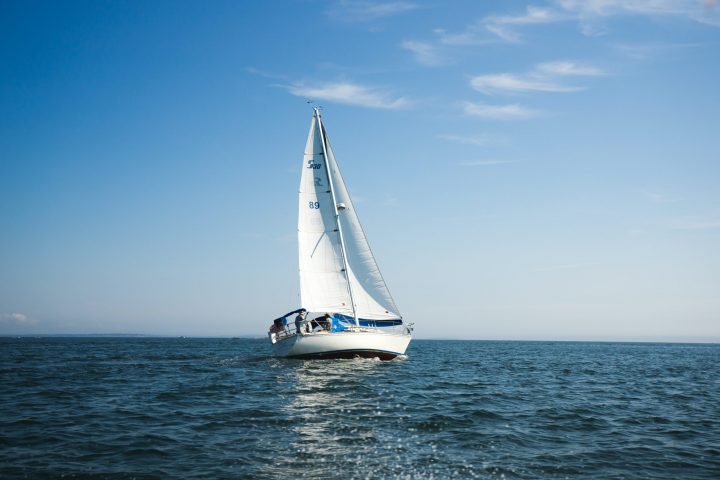
But beyond freeing up space for you and your staff, being able to reef your sails has huge advantages all around. A properly canvased boat will have the best balance and be the easiest to control.
In contrast, boats that are over-canvased will heel too much and have more weather helm. Weather helm is the force on the wheel that makes the boat want to turn into the wind. As the wind pipes up, the weather helm increases. Reducing sail will reduce the effort you or your autopilot has to apply to the wheel.
Crew comfort is another big factor. A yacht that is heel hard over is harder to work, sleep, cook, and live in. If the crew can reduce the heel by 10 or 15 degrees, their comfort will increase exponentially.
Reducing sail is sometimes also done to reduce speed. For example, you might reduce speed on an overnight passage to avoid making landfall before dawn. Or, you might reduce speed to get the boat to ride more comfortably in rough conditions.
Finally, despite sometimes being used to slow down, reefing sometimes can actually increase the performance and speed of a sailboat in high winds! Many boats are designed to sail fastest at a certain heel angle, and when you start exceeding that angle, the boat will slow. Putting a reef in reduces the weather helm and the heel angle, both of which allow the boat to sail faster.
One boat’s performance will vary significantly from another’s, so there are too many factors to make generalizations. Boat owners should practice sailing their boats in various conditions and see how it performs best. Doing so is just part of the process of learning to sail a new boat.
Reefing on Monohulls Versus Multihulls
Reefing is especially important on multihull vessels.
When a monohull sailboat experiences a strong gust, the boat heels over and “spills” the excess air out of the sail. This relieves much of the pressure on the sails and rigging.
On a multihull, the buoyant force from the leeward hull prevents the boat from heeling. In a gust, the sails and rig absorb the excess energy from the gust. That means more wear and tear on the canvas, control lines, and the stainless rigging that holds up the mast.
For this reason, multihulls are more prone to rigging failures than similarly equipped monohulls. Most riggers recommend that all standing rigging should be replaced every decade, but this is doubly important for catamarans and trimarans.
Beyond damage to the rigging, reefing early is imperative to prevent capsizing a multihull. While it certainly takes a great force to tip a cruising boat beyond the point of no return, such a force can result from strong gusts and just the right sea state.
Finally, reefing multihulls in high winds often increases their speed. Flying too much sail in strong winds will result in too much heeling force – and, after all, a catamaran performs best when sailing as flat as possible. So if you’re out sailing your catamaran and a reef increases your speed, chances are you waited a little too long to reef!
Headsail Reefing
The headsail of a modern sloop is called a jib, or in some cases, a genoa. On cruising boats, these are usually heavy sails that contain quite a bit of sail area.
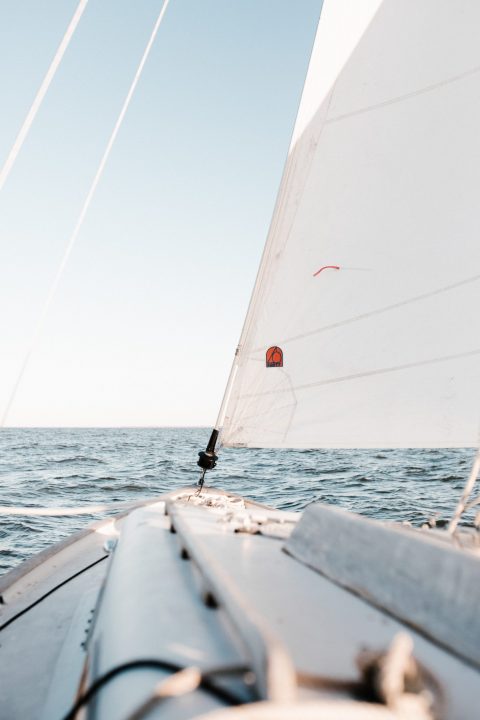
Furling
The most common setup on modern boats is to have the headsail, or headsails, mounted in roller furlers. The sail is then pulled out with the sheets and rolled back in with a single furling line.
Not all furlers are designed to reef the sail.
Those that are capable of reefing accomplish it simply by unrolling the sail only partly. That means there are more or less an infinite amount of reefing positions. Thus, the skipper can pick exactly how much headsail they want out for any condition.
The big disadvantage of roller furling headsails is that they are entirely dependent on a single line to remain furled. Should that line part in storm conditions, the sail will come unfurled quickly and catastrophically.
Many sailors store their sails hung on their furlers full-time. But it’s vitally important to inspect the furling line and ensure that it is secure periodically, lest the sail come out when you least expect it. Therefore, standard heavy-weather prep always includes removing sails from their furlers.
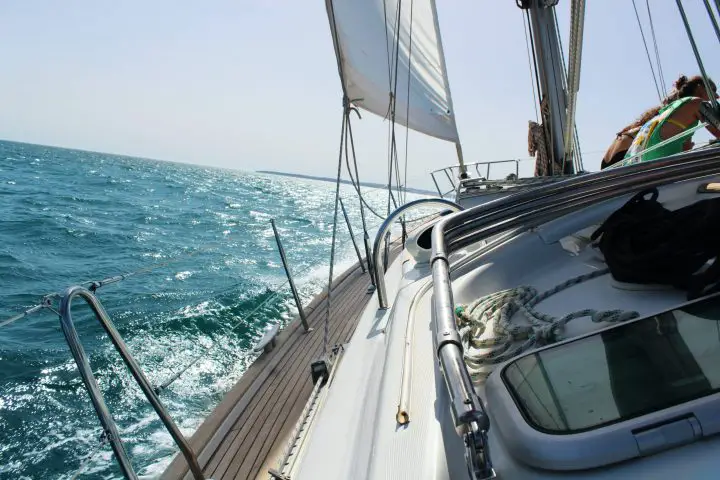
Hank-On Headsails
Before there were roller furling headsails, sails hanked onto the forestay. Hanks are simple clips.
Hank-on sails can’t be rolled. Usually, when the wind gets stronger, a small sail is flown.
A few sail designs can be reefed like mainsails – they are tied off at the bottom and flown at “half-staff.”
Types of Mainsail Reefing
On the typical modern sloop, the mainsail is the most involved sail to reef. There are several different ways of accomplishing it. Here are the main ways of how to reef a mainsail.
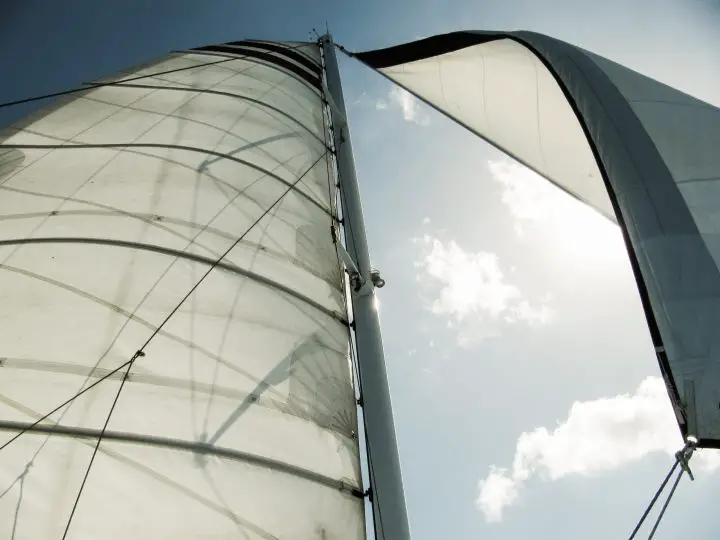
Slab Reefing
A slab reefing system takes a “slab” out of the sail. It is sometimes called “jiffy reefing” because you can put in or take out a reef in a jiffy!
A mainsail with this type of reefing system will have two or more reefing points. At the forward edge of the reefing point will be a reefing tack, which gets attached to a hook on the boom near the gooseneck. At the back of the sail, the reef clew will have a line that runs down to the end of the boom and back to the mast.
To reef the sail, the halyard is let out until the desired reefing point is near the boom. Next, the reefing tack is looped over the hook on the boom. The reefing line, which runs to the clew, is taken in until tight and secured. The main halyard is then brought up to bring tension on the sail’s luff.
To shake out the reef, the process is reversed. To put in a second reef, the process is repeated at the next reefing point.
You can adjust the tension on the reefing line to give the sail more or less shape. Some sails also have small mainsail reefing ties called buntlines looped through the sail so that the foot of the reefed sail can be tidied. In some cases, the buntlines secure a baggy loose footed sail (the “bunt”), and in others, they secure the foot of the reefed sail to the boom.
Like all things sailing, there are a lot of moving parts and ways to adjust your setup. For example, the tension on the boom’s topping lift can be adjusted, as can the position of the clew’s reef line.
Single Line or Two Line Jiffy Reefing
Reefing is done on some yachts entirely at the mast, while on other boats, the reefing lines are rigged to the cockpit. For the system to work perfectly from the cockpit, the lines must be carefully laid to reduce all friction from the system.
It’s also necessary for both the clew and the tack at the reefing point to have control lines led back to the cockpit, along with the main halyard.
On some boats, a single line is run from the sail’s clew, along the boom, through the tack, and then back to the cockpit. Taking up this line puts tension on both the tack and clew at once, meaning fewer lines to adjust.
The simplicity of the single-line reefing system is not without tradeoffs, however. With one line making so many turns, it becomes harder to put the reef in due to friction. It also becomes more challenging to control the sail’s shape since you can’t control the tack and clew independently.
Benefits of Slab Reefing Mainsails
Many sailors prefer slab reefing to other systems, and there are a few reasons why it’s preferable. For one thing, the system is more or less bulletproof. It doesn’t require a lot of special moving parts, and once the sail is reefed, it is very secure in place. If there’s ever a problem, the main halyard can be let go, and the sail should drop.
Slab reefing also allows for the use of full-length sail battens, which provide optimum shape for larger sails. Battens are supports that are built into the sail. Some mainsails have partial battens, while others have full battens. Full battens allow for larger sails, which means more power in lighter winds.
Slab-reefing mainsails can be stored off the boat, wrapped in a sailboat with sail ties around the boom, or inside a special type of sail bag called a stack pack.
A stack pack stores the sail in place and uses lines called lazy jacks to keep it on the top of the mast. When the owner wants to hoist the sail, they simply unzip the stack pack and raise the sail. Releasing the halyard lets the sail drop into the bag with the help of the lazy jacks.
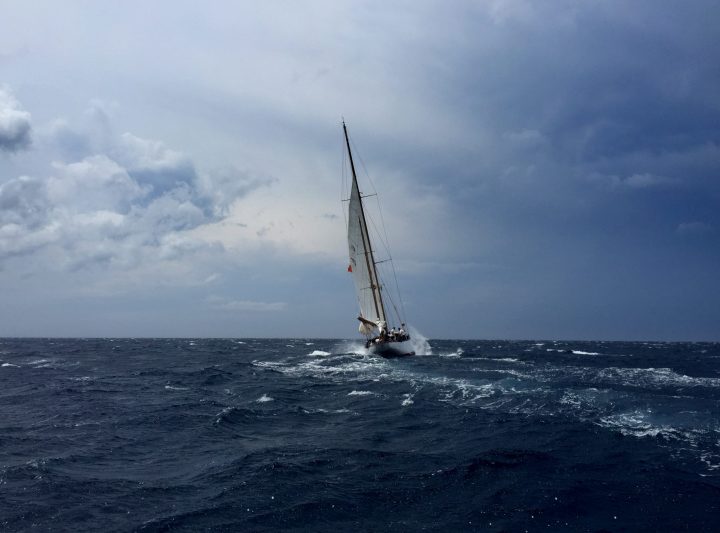
In-Mast Mainsail Reefing
Like headsails, mainsails can also be rolled onto furlers. In most cases, this means that the sail cannot have battens.
The most common type of mainsail furler is built into the mast. When furled, nearly all of the sail is stored inside the mast. This is very tidy and safe for storage, but like furling headsails, you must ensure that the sail is secure during storms.
In-mast furling systems work with two lines, and outhaul and an inhaul. The outhaul pulls the sail’s clew out along the boom, while the inhaul rewinds the sail around the furler inside the mast. The two work together, and you must maintain tension on both during operation.
If tension is not maintained, the sail is not wound tightly around the furler. A messy furl risks a jam, and there’s no way to unjam an in-mast furler without completely unrolling the entire sail. This is the system’s biggest disadvantage. In storm conditions at sea, a jammed furler is a big problem.
But in-mast furlers allow the skipper to put out just enough sail for any condition, and they offer the same ease of use that headsail furlers do. If a boat is equipped with both sails on roller furlers, you can unroll the sails in any combination for quick sailing.
To have in-mast furling, a special mast is needed. If your boat didn’t come with it, there’s not much sense in adding it after the fact. On the other hand, there are behind-the-mast furlers that can accomplish the same task.
Boom Furling Reefing
Beyond the occasional jam, if in-mast furlers have one problem, it is that the sail cannot have battens. On some boats, this means a large reduction in sail area is required.
Boom furlers solve this problem by rolling the sail down and into a unique boom instead of into the mast. The sail can be any size and can have full-length battens.
Overall, the system functions much like an in-mast furler, but the sail gets shorter instead of moving farther forward. On many boats, this has a positive effect on handling and stability as well.
Reef Early and Often
No matter what sort of reefing your boat has, learning how to use it in various conditions is vital to your safety.
Of course, it’s possible to take leisurely day sails and never have to put a reef in, but it will become necessary one day. So like man-overboard drills, practice reefing occasionally to make sure all of your lines are in good shape and build up your skills. That way, when the day comes, you can reduce sail quickly and enjoy sailing in sportier conditions.
FAQ – Questions About Reefing Sails
How many reefs are in a sail?
The number of reef points in a sail depends entirely on the boat and the sail–there is no right or wrong answer.
Most mainsails that use slab reefing have either two or three reef points built into their custom sails. The owner and the sailmaker decide on the number when new sails are ordered. Generally, offshore sails that may get used in rough weather will have more reef points than the sail used for casual coastal sailing.
Sails mounted on roller furlers have an infinite amount of reef points built-in. Thus, reefing is accomplished simply by rolling the sail a little bit or a lot.
